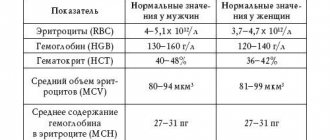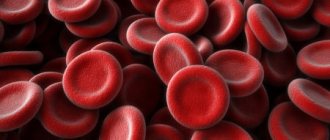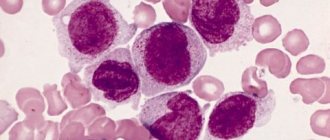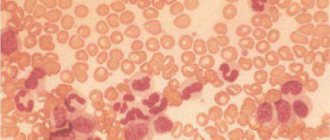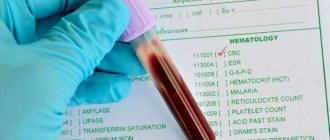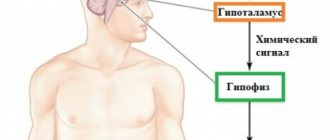What is hematocrit number?
Hematocrit, or hematocrit number, is the percentage of the volume of red blood cells to the total volume of blood plasma. Sometimes in laboratories they calculate the ratio of the volume of all components, and not just red blood cells. But even in this case, the final number will not change by more than 1%, because 99% of the formed components of blood are red blood cells.
Hematocrit is part of the CBC and is studied both routinely and in various pathological conditions. The biomaterial is collected on an empty stomach; blood is taken capillary (from a finger) or venous. Find out how to donate blood for sugar correctly here.
The hematocrit number is calculated according to the following scheme:
- the laboratory assistant fills a glass graduated rod with biological material;
- the stick is sent to a centrifuge and processed;
- After separating blood plasma from formed components, the percentage is calculated.
In addition to the manual counting method, laboratories use automatic analyzers. They are convenient because after filling the test tube with biological material, all further research occurs automatically. The result is issued in the form of a printout of the indicators and compares them with average standards.
Tubes of blood are placed in a special apparatus for analysis.
What does hematocrit show?
HCT is an indicator that indicates the level of red blood cells (erythrocytes) in the blood. These cells are responsible for transporting oxygen to body tissues and internal organs, and transporting carbon dioxide back. Thus, the level of hematocrit can determine the degree of oxygen saturation of tissues.
An increase in the hematocrit number, which is shown in a general blood test, occurs for several reasons:
- dehydration of the body for various reasons (vomiting, diarrhea, burns);
- release of fluid from the vascular bed (edema, ascites, hydrothorax);
- erythremia;
- increase in the number of leukocytes (various diseases, infectious, oncological).
A decrease in hematocrit is a marker of conditions such as:
- anemia of various origins;
- spleen diseases;
- overhydration of the body as a result of infusion therapy;
- pregnancy.
How to increase
If changes in the composition of the blood are detected, the patient is prescribed additional tests that help establish the cause of the deviation from the norm. Later, based on the test results, a suitable treatment method is selected.
So, if the changes were caused by a peptic ulcer, the patient is referred to a gastroenterologist, who prescribes conservative treatment using antiemetic medications, antispasmodics, analgesics, anabolic steroids and immunostimulants. In some cases, surgery is prescribed.
Important information: What is MCV or mean erythrocyte volume in a blood test (deciphering the norm in the results)
For internal bleeding, prolonged menstruation and injuries that cause heavy blood loss, in most cases, injections of an infusion solution are prescribed.
If a decrease in hematocrit is a consequence of the use of medications, then it is recommended to exclude the latter from therapy.
In case of anemia, pregnancy or poor nutrition, the patient is prescribed vitamins and medications in the form of tablets or injections, which are aimed at increasing the level of iron in the body.
In order to prevent a decrease in HCT or stabilize the value in question independently, a patient of any age needs to establish the correct diet and introduce the following foods into the diet:
- raisins, nuts, peas, beans, green spinach, poultry, beef, fish, shrimp, chicken and quail eggs, apples (they are rich in iron);
- tomatoes, broccoli, white, red and cauliflower, oranges, tangerines, rose hips, black and red currants, sea buckthorn, strawberries (contain vitamin C).
In addition, doctors recommend:
- give up foods that are enriched with fiber and calcium;
- move more;
- maintain a drinking regime (adults drink about 2 liters of water per day);
- use hematogen;
- Take iron supplements and vitamins that have a positive effect on the formation of red blood cells.
In some cases, a blood transfusion is required to raise the hematocrit level.
How is it indicated in a blood test?
The hematocrit value is prescribed in a clinical general blood test as HCT (from the English word Hematocrit). In addition to the standard abbreviation HCT, different laboratories may use the following designations in blood tests:
- Ht;
- Crit;
- PCV.
The abbreviation PCV stands for Packed Cell Volume, and is synonymous with hematocrit. Most often found in English-language sources, along with the abbreviation VPRC (volume of packed red cells).
The hematocrit number is traditionally measured as a percentage, but sometimes the unit of measurement is L/L (liter to liter). For example, HCT 45% and HCT 0.45 l/l are the same value in absolute terms. Knowing what HCT or Ht is in a blood test, you can independently monitor the hematocrit level.
Table of norms by age
Reference norms for hematocrit in the blood depend on the patient’s gender and age characteristics, and in addition, the hematocrit number changes throughout life under the influence of external factors.
| Patient category | Average hematocrit in blood |
| Newborns | 40-65% |
| Children under 14 years of age | 30-45% |
| Adult men under 45 years of age | 40-48% |
| Adult men over 45 years of age | 39-51% |
| Adult women under 45 years of age | 36-46% |
| Adult women over 45 years of age | 34-48% |
Indicator for women
The hematocrit index in women is several percent lower than in men of the same age, and amounts to 36-46%. With age, HCT increases, but only slightly (in the absence of specific factors). The table above shows the norm for women up to 45 years of age and older. After 65 years, the norm of hematocrit in the blood of women is 35-47%. Sugar levels, hemoglobin and leukocyte levels.
Norm for men
The hematocrit number for men is usually in the range of 40-48%. The HCT rate in men is higher due to physiological differences. High testosterone levels affect muscle gain, which leads to an increase in the volume of oxygen and, accordingly, red blood cells. In addition, men do not experience regular blood loss, unlike women. The table above shows the norm of hematocrit in men by age up to 45 years and older. Indicators of glucose, cholesterol and leukocytes in the blood of men.
Importance in children
In the table, the hematocrit norm in children is divided by age. In newborns, the hematocrit indicator is somewhat overestimated, and is in the range of 40-65%. In the infancy period, NST first drops to 30%, and then, with growth, the norm in children begins to gradually increase to 45%.
The indicated boundaries for any of the categories cannot be considered absolute, since each laboratory prints its own standards in the test results. You should focus specifically on the reference values provided by the medical organization.
What does elevated levels mean in adults?
A deviation of hematocrit from the norm in one direction or another indicates various pathological processes in the body. The process of hematopoiesis is enhanced in pulmonary diseases such as obstructive bronchitis and bronchial asthma. The person cannot breathe normally and therefore experiences a lack of oxygen. The body compensates for this condition by producing more red blood cells. As a result, the hematocrit number increases.
The same is typical for late toxicosis during pregnancy, which disrupts kidney function and increases the content of red blood cells. Its thickening is observed closer to childbirth. This helps prepare a woman's body for childbirth, which is often accompanied by heavy blood loss. An increase in HCT is also observed with:
- hydronephrosis;
- polycystic disease;
- uncontrolled use of diuretics or corticosteroids;
- suffered stress;
- diseases of the bone marrow or its condition after chemotherapy;
- skin injuries;
- gastrointestinal diseases;
- non-compliance with the proportions of proteins, carbohydrates and fats in the diet;
- erythrocytosis with congenital heart defects, peritonitis, uncontrollable vomiting, diabetes mellitus.
HCT levels can be reduced by changing your diet. It is necessary to drink more fluids, stop smoking and alcohol, and consume more foods with antioxidants. Grapefruit thins the blood. The flavonoid in its composition normalizes the properties of erythrocyte membranes, reducing their aggregation. If necessary, drugs from the category of anticoagulants and antiplatelet agents are prescribed. This treatment is indicated only for elevated hematocrit. Erythrocytepheresis also helps reduce HCT levels.
Causes of increased blood density
When the number of red blood cells is increased, the thickness of the blood increases. This is observed in different conditions of the human body, both physiological and pathological. So, hematocrit is increased when:
- Hypoxia . This is a chronic lack of oxygen that leads to an increase in the concentration of red blood cells. If a person spends a long time in a stuffy room, constantly smokes or suffers from diabetes, he is characterized by a state of hypoxia.
- Dehydration . Lack of fluid in the body causes moisture deficiency, which reduces plasma concentration. As a result, the ratio of red blood cells to its volume increases, which is reflected by a high hematocrit. This is observed after attacks of vomiting, diarrhea, overheating and too active physical activity, which is accompanied by active sweating.
- Staying in mountain conditions . Accompanied by hypoxia, i.e. lack of oxygen. This is observed when being in mountainous areas. Thin air contains less oxygen, so the body begins to produce more red blood cells. Oxygen cartridges help people working in mountainous areas and climbers avoid hypoxia.
What is dangerous for the heart and blood vessels?
Due to blood thickening, the risk of thrombosis increases significantly. For this reason, red blood cell counts are important for patients with heart and vascular diseases. Due to blockage of blood vessels and the formation of blood clots in the arteries, the load on the heart increases significantly. If it is weakened, it practically wears out. The result can even be a myocardial infarction.
With an increase in the number of platelets, arterial thrombosis is formed, which causes the stage of ischemia. It leads to oxygen starvation and subsequent tissue death. Fluid accumulation in heart failure also leads to increased HCT levels. If this indicator crosses the border of 50-55%, then the patient needs to be urgently hospitalized. To thin the blood to normal levels, he is prescribed anticoagulants. The simplest among them is Aspirin.
Normal hematocrit number during pregnancy
During pregnancy, serious hormonal changes occur in the body, and the load on many internal organs increases. The HCT rate in pregnant women also changes throughout the entire period of pregnancy.
Early
In the first trimester of pregnancy, the average hematocrit in the blood is about 33%. A low level indicates anemia and requires a doctor's prescription. An increased level of hematocrit in the first trimester indicates dehydration of the body (for example, as a result of toxicosis) and a threatening condition for the woman and the fetus.
In the 2nd trimester
The hematocrit rate during pregnancy for the 2nd trimester increases slightly and is at the level of 36%. Regular clinical blood tests during pregnancy allow you to monitor the level of hematocrit and hemoglobin.
NTS in the 3rd trimester
In the last weeks of pregnancy, the volume of blood in the mother’s body increases, which leads to a slight decrease in the hematocrit number. During pregnancy, the norm is 3 trimesters - 34%.
If the hematocrit is below the average, your doctor may diagnose pregnancy anemia. And an increased level indicates gestosis (edema).
Why is the level lowered?
If the number of red blood cells in the blood of an adult decreases and their level drops to the lowest level (20-25%), then the liquid becomes thick and the HCT value changes. In this case, there is a risk of developing hypoxia, which can lead to loss of ionized calcium, salt deposition and changes in the functioning of organs.
Possible reasons for a decrease in hematocrit in people of any gender are the following:
- blood loss (heavy menstruation, injuries and fractures, uterine bleeding);
- violation of the formation of red plates in the bone marrow (leukemia, anemia);
- the appearance of malignant tumors (myeloma, hemoblastosis);
- acute poisoning and infection (malaria, typhoid fever);
- changes in the protein structure of hemoglobin;
- pathology of the vascular system (atherosclerosis, thrombosis);
- autoimmune diseases (rheumatoid arthritis, lupus erythematosus);
- diseases of the kidneys (pyelonephritis, glomerulonephritis, polycystic disease) and liver (hepatitis, cirrhosis, opisthorchiasis);
- dysfunction of the excretory system;
- prolonged immobilization;
- lack of iron, folic acid, vitamin B12.
In younger people, a low hematocrit can be caused by several reasons:
- accelerated growth;
- fasting or unbalanced diet;
- diseases of the digestive tract, which result in impaired iron absorption.
Among women
If a woman's hematocrit is low, then one of the following conditions is present:
- pregnancy or recent childbirth;
- chronic kidney and heart diseases;
- nicotine addiction;
- insufficient amount of iron in the diet.
During pregnancy
During gestation, a woman's BCC (circulating blood volume) increases, changes in kidney function occur, fluid accumulates in the subcutaneous fat and tissues of internal organs, and edema often appears. All these phenomena are considered physiological causes of a decrease in hematocrit.
Important information: How to quickly reduce leukocytes in the blood using folk remedies (which foods lower them)
Conditions that reduce HCT may include:
- severe toxicosis;
- bearing several fruits;
- young age of the patient;
- short period between pregnancy and previous birth.
Low hematocrit during pregnancy is a natural phenomenon. However, this does not mean that a woman cannot control her blood condition and HCT level. In some cases, the presence of such processes in the body signals the development of pathologies (immune system dysfunction, kidney and liver dysfunction, infections, anemia, gastritis, lack of vitamins) and can lead to hypoxia and complications during childbirth.
In men
A decrease in hematocrit levels in men most often indicates that the patient abuses alcohol and tobacco products, and also leads a sedentary lifestyle. Other common reasons include:
- diseases of the gastrointestinal tract;
- tumor processes;
- long-term chemotherapy.
False downgrade
In some cases, tests may indicate a decrease in HCT, but this will be a false result. This can happen if the patient took a blood thinner before donating blood, or if the patient had a vein compressed for a long time.
Other reasons for a false decrease in hematocrit include the following conditions and pathologies:
- diabetes;
- poisoning;
- vomiting and diarrhea;
- fatigue after prolonged physical activity.
